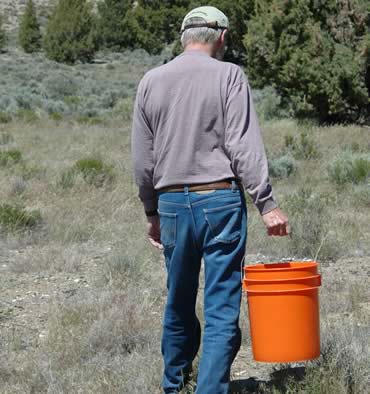Don’t attempt a shot in the field you haven’t practiced at the range.
Photo: Life-size targets are a good alternative to 5-gallon buckets for determining maximum effective range.
A small herd of elk was feeding along a logging road winding up a ridgeline more than a half-mile distant. In the bunch was a raghorn bull surrounded by a half-dozen cows.
While contemplating what it would take to get to their side of the mountain, I saw dirt kick up 6 feet in front of the bull. A split second later, I heard a rifle report.
I was glassing the animals from a roadside. Dirt kicked up four more times, each followed by another report.
Fortunately, none of the elk were hit or wounded. After the first couple of shots, they began heading over the ridge.
I drove to the next plateau just in time to see the shooter — I wouldn’t call him a hunter — put his rifle in his pickup and drive off in a hurry.
I ranged the shooting distance from where he had been parked. It was more than 700 yards!
The shooter had little chance of taking even a large animal at that distance. It was much more likely he’d wound one. Given the terrain and cover, a seasoned hunter could have gotten within range of the bull with a little time and effort.
 Although it happened many years ago, the event is still fresh in my mind. The memory surfaces every now and then when I hear hunters discussing their long-range shooting ability.
Although it happened many years ago, the event is still fresh in my mind. The memory surfaces every now and then when I hear hunters discussing their long-range shooting ability.
Knowing one’s effective hunting range is not hard to determine. If you can keep three shots inside 1 1/2 inches at 100 yards, that means 3 inches at 200 yards, 4 1/2 inches at 300 yards, and so on. Keep in mind, however, that is with a stable rifle rest under ideal conditions.
A hunter should be confident in his ability to make a lethal shot before attempting it. A good way to establish the effective range is to take a 5-gallon bucket and set it out at 200 yards. The bucket is approximately the size of the kill zone of most big game. A life-size target will also work.
From the shooting position you normally use in the field, take a shot. If it hits, move the bucket farther back in 50-yard increments until you can’t hit it on the first try. With practice, your effective range will increase.
Be a hunter, not just a shooter, and pull the trigger only when you have confidence in your ability to take game on the first shot.
Read Recent GunHunter Articles:
• Sage Goats With a Slug Gun? The author travels to Wyoming to push the envelope of slug gun performance.
• Barrel Fluting: What Does It Do? Fluting makes a barrel distinctive, but there are other benefits, too.
This article was first printed in the October 2011 edition of Buckmasters GunHunter Magazine. Subscribe today to have GunHunter delivered to your home.